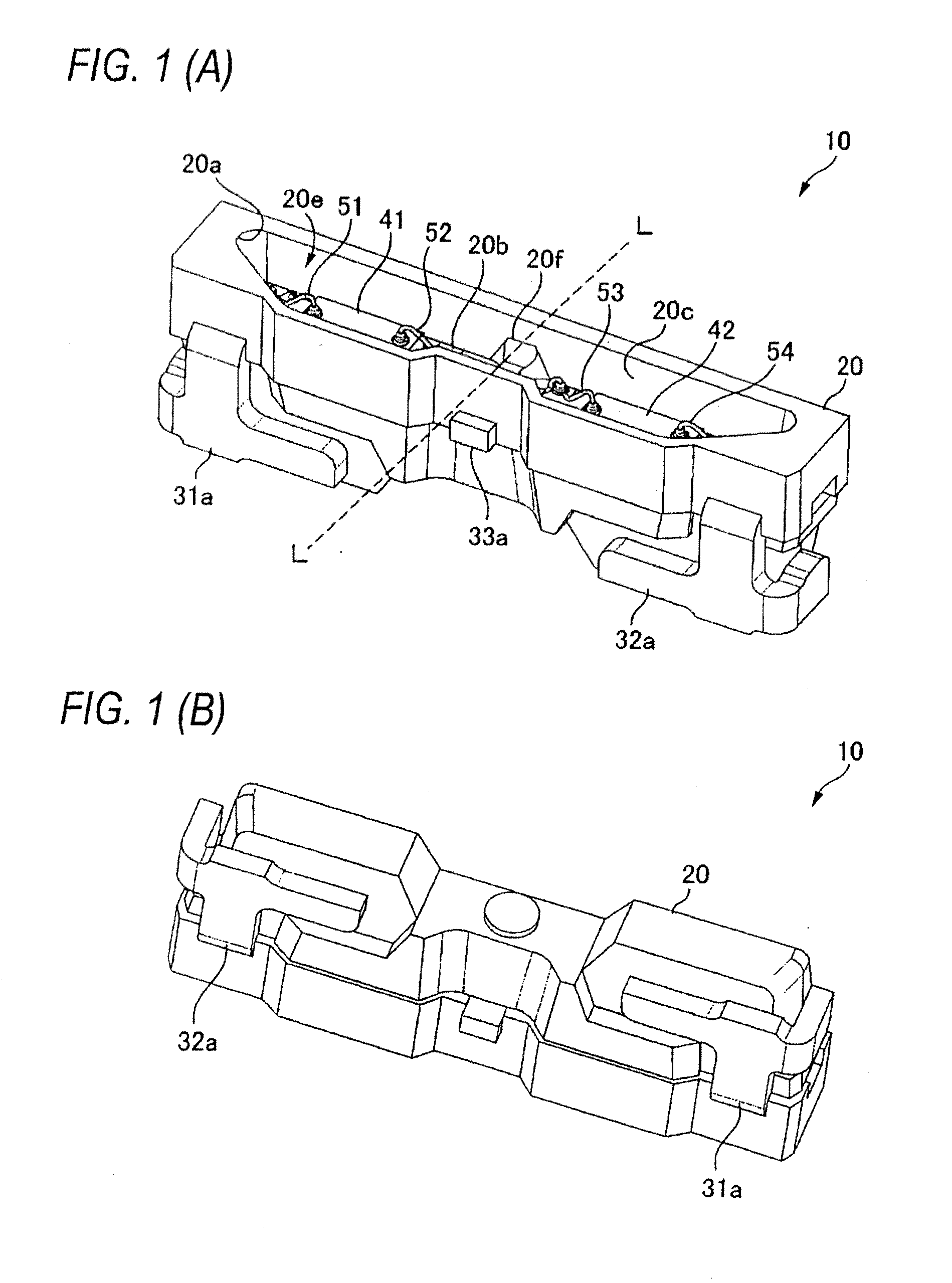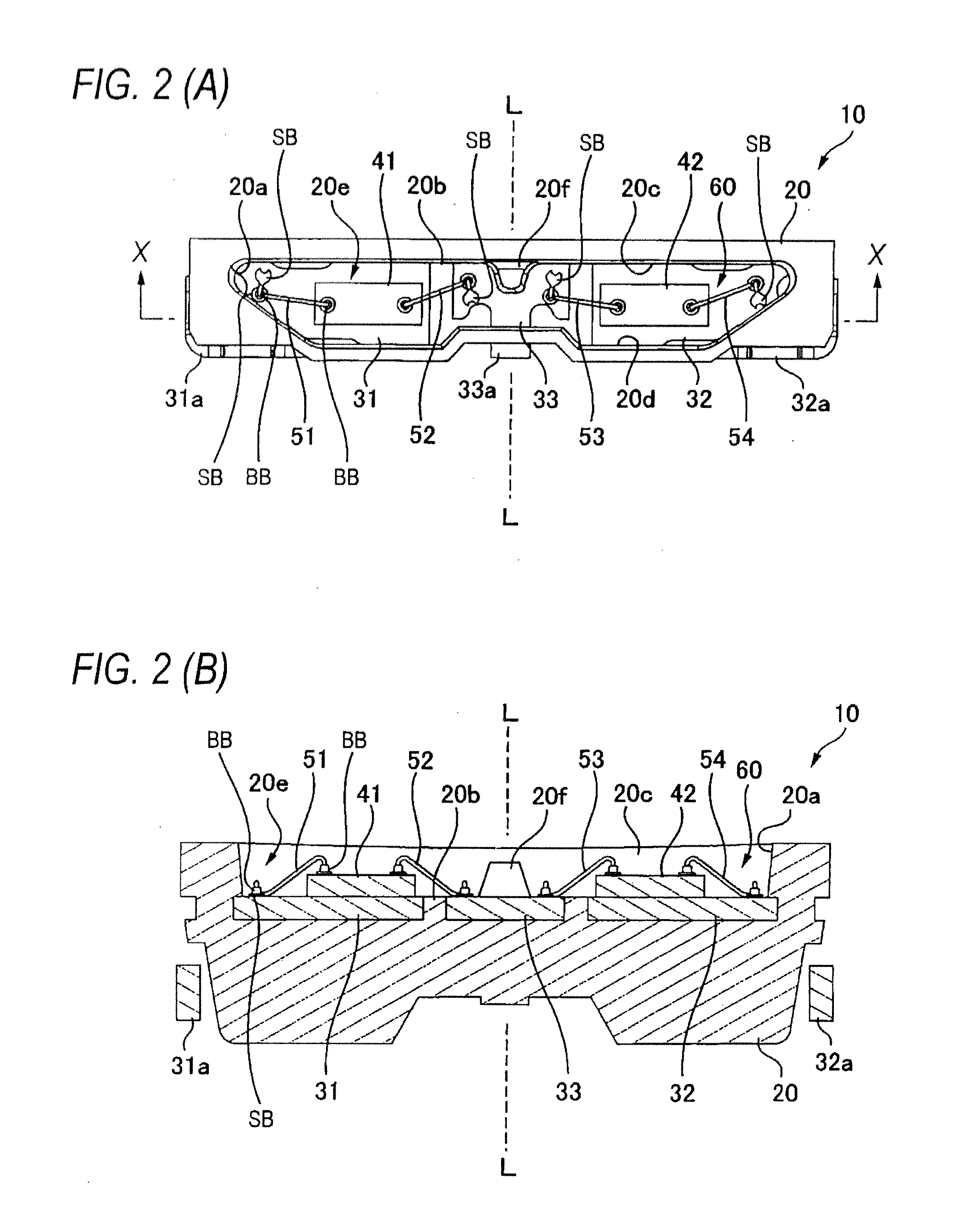Light emitting device
a technology of light emitting devices and side views, which is applied in the direction of solid-state devices, lighting and heating devices, lighting support devices, etc., can solve the problems of reducing reliability, affecting the effort to form a thinner and smaller light emitting device, and uneven stress distribution, so as to prevent the breakage of bonding wires and improve reliability.
- Summary
- Abstract
- Description
- Claims
- Application Information
AI Technical Summary
Benefits of technology
Problems solved by technology
Method used
Image
Examples
embodiment 1
Operation and Advantages of Embodiment 1
[0073]The operation and advantages of the light emitting device 10 in Embodiment 1 are as follows.
[0074](1) The lead frames 31 to 33 are arranged side-by-side in the longitudinal direction of the case 20 and are buried there. The outer surfaces of the lead frames 31 to 33 are exposed from the bottom surface of the accommodating recession 20e, and the outer surfaces of the lead frames 31 to 33 are formed flush with the bottom surface of the accommodating recession 20e, and the surfaces of the lead frames 31 to 33 are arranged coplanar with each other.
[0075]The light emitting elements 41, 42 are carried in the lead frames 31, 32 arranged in the two end portions in the longitudinal direction of the case 20. The lead frames 31 to 33, the case 20 and the light emitting elements 41, 42 are formed in a linear symmetric configuration with respect to the central line L that bisects the longitudinal direction of the light emitting device 10.
[0076]In oth...
second embodiment
[0090]As shown in FIG. 3, the light emitting device 100 of Embodiment 2 is a side view-type light emitting device including the case 20 (opening portion 20a, bottom surface 20b, inner side surfaces 20c, 20d, accommodating recession 20e, and column-shaped part 20f), lead frames 31 to 33, light emitting elements 41, 42, bonding wires 51 to 54, sealing resin 60, etc.
[0091]The case 20 in Embodiment 2 is the same as the case 20 in Embodiment 1. Consequently, the oblique view of the light emitting device 100 is similar to the light emitting device 10 in Embodiment 1 as shown in FIG. 1.
[0092]Embodiment 2 differs from Embodiment 1 in that the light emitting elements 41, 42 are not arranged in a linear asymmetric configuration with reference to the central line L, and the distance from the light emitting device 41 to the inner side surface 20c of the case 20 is shorter than the distance from the light emitting device 42 and the inner side surface 20c.
[0093]That is, in Embodiment 2, the ligh...
embodiment 3
[0099]As shown in FIG. 4, the light emitting device 200 of Embodiment 3 is a side view-type light emitting device including a case 20 (opening portion 20a, bottom surface 20b, inner side surfaces 20c, 20d, accommodating recession 20e, and column-shaped part 20f), lead frames 31 to 33, light emitting elements 41, 42, bonding wires 51, 54, 201, sealing resin 60, etc.
[0100]In Embodiment 3, the case 20 is the same as the case 20 of Embodiment 1. Consequently, the oblique view of the light emitting device 200 is nearly the same as the light emitting device 10 in Embodiment 1 shown in FIG. 1.
[0101]Embodiment 3 differs from Embodiment 1 in the following features.
[0102][a] It does not have the lead frame 33 and the bonding wires 52, 53.
[0103][b] The light emitting elements 41, 42 are directly connected with the bonding wire 201 without via lead frames.
[0104][c] It does not have the column-shaped part 20f.
[0105]Consequently, Embodiment 3 can also have the same operation and advantages as th...
PUM
 Login to View More
Login to View More Abstract
Description
Claims
Application Information
 Login to View More
Login to View More - R&D
- Intellectual Property
- Life Sciences
- Materials
- Tech Scout
- Unparalleled Data Quality
- Higher Quality Content
- 60% Fewer Hallucinations
Browse by: Latest US Patents, China's latest patents, Technical Efficacy Thesaurus, Application Domain, Technology Topic, Popular Technical Reports.
© 2025 PatSnap. All rights reserved.Legal|Privacy policy|Modern Slavery Act Transparency Statement|Sitemap|About US| Contact US: help@patsnap.com



